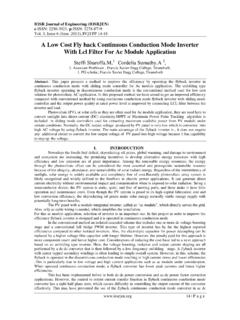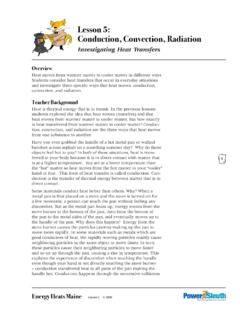Transcription of AN604 Application note - st.com
1 August 2011 Doc ID 3607 Rev 31/12AN604 Application noteCalculation of conduction losses in a power rectifierIntroductionThis Application note explains how to calculate conduction losses in a power diode by taking into account the forward voltage dependence on temperature and the current ideal current and voltage waveforms of an ultrafast diode in a power supply system during a switching cycle are shown in Figure current and voltage waveforms of a diode in a switch mode power supplyThe conduction losses in a diode appear when the diode is in forward conduction mode due to the on-state voltage drop (VF). Most of the time the conduction losses are the main contributor to the total diode power losses and the junction temperature rising. This is the reason why it is important to accurately estimate (t)VD(t)VD(t)IMaxIMinttID(t)VRVF00 Tsw TswFSwitching frequencyTSwitching periodDuty cycleTDuration of diode conductionIMaximum forward currentIMinimum forward currentVForward voltageVReverse voltageswswswmaxminFR ID 3607 Rev 3 Contents1 Diode forward characteristics.
2 Temperature dependence .. forward characteristics modeling: VT0(Tj), RD(Tj) .. 32 conduction losses: basic equations .. parameters: average and rms currents .. 63An Application example .. and rms current calculation .. (Tj) and RD (Tj) calculation .. losses expression .. 104 Revision history .. 11AN604 Diode forward characteristicsDoc ID 3607 Rev 33/121 Diode forward Junction temperature dependenceFor two different junction temperatures, the current versus forward voltage curves cross at a current level point Ic, depending on the diode technology. When the current is lower than Ic, the temperature coefficient VF of the forward voltage is negative. When the current is higher, the temperature coefficient becomes positive. This behavior is shown in Figure 2. For Schottky and bipolar diodes, Ic is high and the working area corresponds to VF < 0. For SiC and GaN technologies, Ic is low and the VF can be positive or negative.
3 When of VF < 0, the forward voltage and the conduction losses decrease when the junction temperature (IF,VF) characteristics of a Diode forward characteristics modeling: VT0(Tj), RD(Tj)Forward characteristics (IF and VF) can be modeled by a straight line defined by a threshold voltage VT0, and a dynamic resistance RD. VT0 and RD are calculated for 2 forward current levels (IF1, IF2) for a given junction temperature as shown in Figure 3. Thus we can write:Equation 1 Equation 2 Using Equations 1 and 2, we obtain VT0(Tj) and RD(Tj) expressions: Equation 3 Equation 4 VF> 0 VFIF VF< 0Tj2>Tj1Tj1 VF= 0Ic01 FjDjT0j1 FFI)(TR)(TV)T,(IV +=2 FjDjT0j2 FFI)(TR)(TV)T,(IV +=1F2Fj1 FFj2 FFjDII)T,(IV)T,(IV)(TR =1F2F1Fj2FF2Fj1 FFjT0 III)T,(IVI)T,(IV)(TV =Diode forward characteristicsAN6044/12 Doc ID 3607 Rev 3 Figure (Tj) and RD(Tj) parametersVT0 and RD are given in each ST diode datasheet. In most cases they are calculated at 125 C with maximum VF values for IF1 = IF(AV) and IF2 = 2 IF(AV), where IF(AV) is the average forward current rating of the diode.
4 For a quick calculation these values can be used. For more accurate estimation, RD and VT0 must be calculated using the specific Application conditions. See the example in Chapter (IF1,TjRef2)VF(IF2,TjRef2)VF(IF1,TjRef1) VF(IF2,TjRef1)VT0(TjRef2)VT0(TjRef1)TjRe f2>TjRef1VF(IF,TjRef2)VF(IF,TjRef1))(jre f2 DTR1)(jref1 DTR1AN604 Diode forward characteristicsDoc ID 3607 Rev 35/12 For any junction temperature VT0(Tj), RD(Tj) and the forward voltage drop VF(IF,Tj) can be calculated as follow:Equation 5 Equation 6 Equation 7 Where VTO and RD are thermal coefficients calculated from the 2 reference temperatures: Tjref1 and Tjref2. A common choice of Tjref1 and Tjref2 is 25 C and 125 C. These thermal coefficients are calculated with the following equations:Equation 8 Equation 9 Note: VT0 < 0 and RD > 0 whatever the diode technology.()jRef1jT0 VjRef1T0jT0TT )(TV)(TV +=()jRef1jDRjRef1 DjDTT )(TR)(TR +=()()FDRT0 VjRef1jjRef1 FFjFFI TT)T,(IV)T,(IV + +=() ()jref1jref2jref1T0jref2T0T0 VTTTVTV =() ()jref1jref2jref1 Djref2 DDRTTTRTR = conduction losses: basic equationsAN6046/12 Doc ID 3607 Rev 32 conduction losses: basic equationsConduction losses are the average dissipated power in the diode during the forward conduction phase given in Equation 10:Equation 10 Equation 10 can also be written as follows:Equation 11 Where IF(AV) is the forward average current and IF(RMS) is the forward root mean square current flowing through the :In case of a square waveform, a short formula can be used to calculate conduction losses:Equation Application parameters: average and rms currentsThe average and rms currents are different for each Application condition.
5 They can be calculated using Equations 12 (average current) and 13 (rms current).Equation 13 Equation 14 Figure 4 presents simplified expression of average and rms currents of commonly observed waveforms in a power rectifier. In most cases, these waveforms can be used for a rough estimation.()dt(t)IT,IVT1)(TPswT0 FjFFswjCOND = 2F(rms)jDF(av)jT0jCONDI)(TRI)(TV)(TP + = I)T,(IV)(TPF(AV)jFFjCOND =() =swT0 FswAVFdttIT1I)(() =swT02 FswRMSFdttIT1I)( AN604 conduction losses: basic equationsDoc ID 3607 Rev 37/12 Figure and rms currents of commonly observed waveformsSquare waveformtID(t)0 Tsw TswIMaxTrapezoidal waveformTsw TswtID(t)0 IMaxIMin = =MaxRMSFMaxAVFIIII)()( ++= +=3 IIIII2 IIIMinMax2 Min2 MaxRMSFMinMaxAVF)()(tID(t)0 IMaxTsw Tsw2 III2 IMaxRMSFMaxAVF = =)()(Half period sinusoidal waveformtID(t)0 IMaxTsw TswTriangular waveform3II2 IIMaxRMSFMaxAVF = =)()(An Application exampleAN6048/12 Doc ID 3607 Rev 33 An Application exampleLet us consider the example of a 90 W notebook adapter.
6 This is a flyback converter (Figure 5) working in continuous mode. The output voltage Vout is 19 V and the maximum output current is A. The rectifier diode is an ST power Schottky STPS30M100S. Figure 6 shows the ideal waveforms of the diode: IMin = 4 A, IMax = A and = us calculate the maximum conduction losses in the diode for this converterFigure current and voltage waveforms of the diode in the flyback LineVD(t)IMaxIMinttID(t)VRVF00 Tsw TswAN604An Application exampleDoc ID 3607 Rev 39 Average and rms current calculationThe first step is the calculation of the average and rms forward average current is the output current: IF(AV) = Iload = illustrated in Figure 6, the forward current has a trapezoidal shape. The formula to calculate the rms current of trapezoidal waveform is given in Figure 4. IF(RMS) is then:Equation VT0 (Tj) and RD (Tj) calculationThe second step is the calculation of VT0 (Tj) and RD (Tj) in the Application condition forward voltage drop versus forward currentTjref1 = 25 C and Tjref2 = 125 C.
7 To calculate maximum conduction losses, read maximum values of VF at IMin and IMax in Figure 7. This figure is available in the STPS30M100S datasheet. These values are summarized in Table 1. ()() (RMS)= ++=Table (Max) values at IMin and IMaxIF (A)VF(Max)(IF, 25 C) (V)VF(Max)(IF, 125 C) (V)IMin = = 4 AIMax= (Typical values)T = 125 Cj(Maximum values)T = 125 Cj(Maximum values)T = 25 CjIFMAn Application exampleAN60410/12 Doc ID 3607 Rev 3 From Equations (3), (4), (8) and (9) calculate VT0(Tjref1), VT0(Tjref2), RD(Tjref1), RD(Tjref2), VT0 and RD. Calculated values of these parameters are summarized in Table 2. From Equations 5 and 6 we can write VT0(Tj) and RD(Tj) as follow:Equation 16 Equation conduction losses expressionFrom Equations 7, 15 and 16 the expression for maximum conduction losses is then:Equation 18 Finally, let us plot the value of conduction losses in the diode as a function of the junction temperature (Figure 8).
8 Figure conduction losses versus junction temperatureTable , RD, VT0, and RD parametersTjref ( C)VT0 (V)RD (m ) VT0 (V C-1) RD ( C-1)Tjref1 = 10-6 Tjref2 = )(TV = )(TR + =j-3jCOND(Max) )(TP += (T)COND(Max)j25 C 35 C 45 C 55 C 65 C 75 C 85 C 95 C105 C 115 C 125 CTjAN604 Revision historyDoc ID 3607 Rev 311/124 Revision history Table revision historyDateRevisionChangesAug-19931 Initial release03-May-20042 Stylesheet update. No content change24-Aug-20113 Completely revised for currently available ID 3607 Rev 3 Please Read Carefully:Information in this document is provided solely in connection with ST products. STMicroelectronics NV and its subsidiaries ( ST ) reserve theright to make changes, corrections, modifications or improvements, to this document, and the products and services described herein at anytime, without ST products are sold pursuant to ST s terms and conditions of are solely responsible for the choice, selection and use of the ST products and services described herein, and ST assumes noliability whatsoever relating to the choice, selection or use of the ST products and services described license, express or implied, by estoppel or otherwise, to any intellectual property rights is granted under this document.
9 If any part of thisdocument refers to any third party products or services it shall not be deemed a license grant by ST for the use of such third party productsor services, or any intellectual property contained therein or considered as a warranty covering the use in any manner whatsoever of suchthird party products or services or any intellectual property contained OTHERWISE SET FORTH IN ST S TERMS AND CONDITIONS OF SALE ST DISCLAIMS ANY EXPRESS OR IMPLIEDWARRANTY WITH RESPECT TO THE USE AND/OR SALE OF ST PRODUCTS INCLUDING WITHOUT LIMITATION IMPLIEDWARRANTIES OF MERCHANTABILITY, FITNESS FOR A PARTICULAR PURPOSE (AND THEIR EQUIVALENTS UNDER THE LAWSOF ANY JURISDICTION), OR INFRINGEMENT OF ANY PATENT, COPYRIGHT OR OTHER INTELLECTUAL PROPERTY EXPRESSLY APPROVED IN WRITING BY TWO AUTHORIZED ST REPRESENTATIVES, ST PRODUCTS ARE NOTRECOMMENDED, AUTHORIZED OR WARRANTED FOR USE IN MILITARY, AIR CRAFT, SPACE, LIFE SAVING, OR LIFE SUSTAININGAPPLICATIONS, NOR IN PRODUCTS OR SYSTEMS WHERE FAILURE OR MALFUNCTION MAY RESULT IN PERSONAL INJURY,DEATH, OR SEVERE PROPERTY OR ENVIRONMENTAL DAMAGE.
10 ST PRODUCTS WHICH ARE NOT SPECIFIED AS "AUTOMOTIVEGRADE" MAY ONLY BE USED IN AUTOMOTIVE APPLICATIONS AT USER S OWN of ST products with provisions different from the statements and/or technical features set forth in this document shall immediately voidany warranty granted by ST for the ST product or service described herein and shall not create or extend in any manner whatsoever, anyliability of and the ST logo are trademarks or registered trademarks of ST in various in this document supersedes and replaces all information previously ST logo is a registered trademark of STMicroelectronics. All other names are the property of their respective owners. 2011 STMicroelectronics - All rights reservedSTMicroelectronics group of companiesAustralia - Belgium - Brazil - Canada - China - Czech Republic - Finland - France - Germany - Hong Kong - India - Israel - Italy - Japan - Malaysia - Malta - Morocco - Philippines - Singapore - Spain - Sweden - Switzerland - United Kingdom - United States of

















